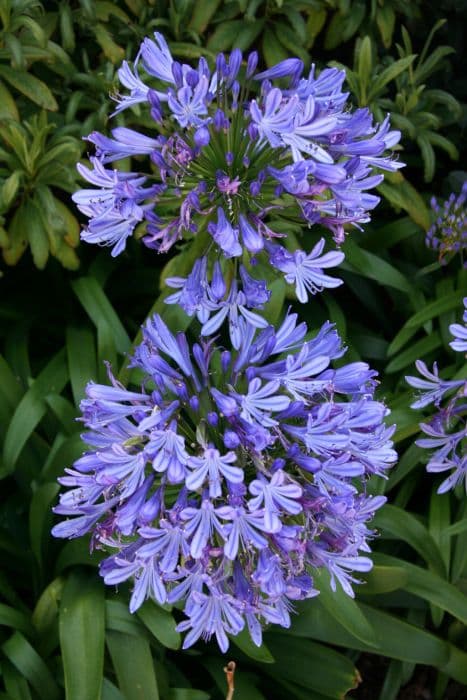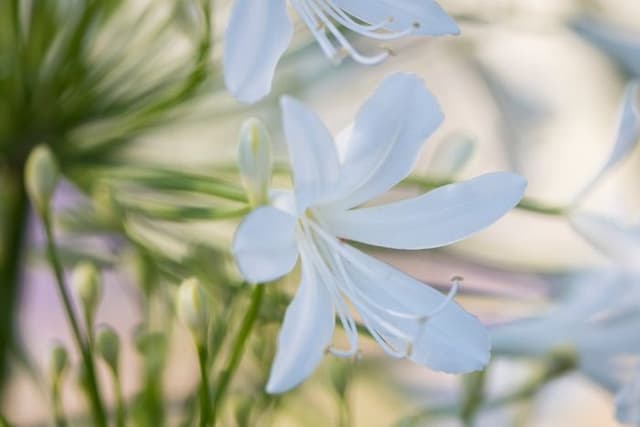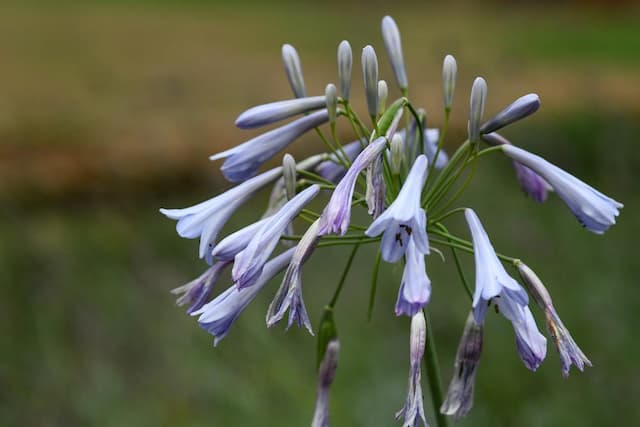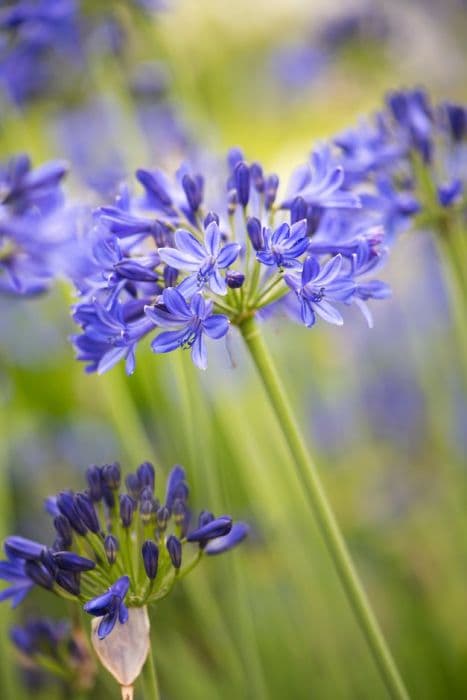African lily Agapanthus 'Hanneke'

ABOUT
Agapanthus 'Hanneke', more commonly known as the African Lily or Lily of the Nile, is an attractive perennial that forms a clump of strap-shaped, green leaves. These leaves create a lush, grassy backdrop for its show-stopping blooms. The flowering stalks are sturdy and rise above the foliage, each bearing a cluster of funnel-shaped flowers. The blossoms of 'Hanneke' are typically a beautiful shade of blue or blue-violet and have a striking, almost spherical appearance when viewed from a distance, with numerous individual flowers giving it a fluffy texture up close. The blooms are arranged in an umbel at the top of the stalk, creating a rounded, globe-like shape. The African Lily exhibits a neat and tidy form, making it a favorite among gardeners for borders or as a focal point in garden beds. Even when not in bloom, the plant provides architectural interest with its fountain of dark green leaves. The foliage is long and arching, creating a visual effect that contrasts well when planted among other perennials with different leaf shapes and textures.
About this plant
 Names
NamesFamily
Amaryllidaceae
Synonyms
African Lily, Lily of the Nile, Love Flower
Common names
Agapanthus 'Hanneke'.
 Toxicity
ToxicityTo humans
The common name for Agapanthus 'Hanneke' is Lily of the Nile. The plant is considered mildly toxic to humans if ingested. Symptoms of poisoning can include nausea, vomiting, and diarrhea. Eating parts of the plant, particularly the roots and leaves, may lead to these symptoms because it contains small amounts of toxic compounds. While serious cases are rare, it's advisable to avoid ingesting any part of the plant and to seek medical attention if symptoms occur after ingestion.
To pets
The common name for Agapanthus 'Hanneke' is Lily of the Nile. This plant is also toxic to pets, including dogs and cats. If ingested, pets may experience symptoms such as nausea, vomiting, diarrhea, and abdominal pain. In some cases, more severe reactions could occur, although this is less common. Pet owners should prevent their animals from eating any part of the plant and consult a veterinarian immediately if they suspect their pet has ingested Lily of the Nile.
 Characteristics
CharacteristicsLife cycle
Perennials
Foliage type
Evergreen
Color of leaves
Green
Flower color
Blue
Height
2 feet [60 cm]
Spread
2 feet [60 cm]
Plant type
Bulb
Hardiness zones
9
Native area
South Africa
Benefits
 General Benefits
General Benefits- Attractive Blooms: Agapanthus 'Hanneke', commonly known as Lily of the Nile, features showy blue or white flowers that add aesthetic appeal to gardens and landscapes.
- Drought Tolerance: Once established, Lily of the Nile is relatively drought-tolerant, making it suitable for xeriscaping and low-water gardens.
- Easy to Care For: This plant has a reputation for being low maintenance and easy to care for, requiring minimal attention once settled into its growing environment.
- Long Blooming Period: The Lily of the Nile typically has a long blooming period, which provides color and interest in the garden for an extended time over the summer.
- Deer Resistance: The plant is known to be resistant to deer, which is beneficial for gardeners in areas where deer predation is a problem.
- Attracts Pollinators: The flowers of the Lily of the Nile attract pollinators such as bees and butterflies, which are beneficial for the garden ecosystem.
- Versatility: This plant can be grown in containers or in the ground, offering flexibility in garden design and use of space.
- Coastal Tolerance: Lily of the Nile is tolerant of coastal conditions, such as salt spray and sandy soils, making it ideal for seaside gardens.
 Medical Properties
Medical PropertiesThis plant is not used for medical purposes.
 Air-purifying Qualities
Air-purifying QualitiesThis plant is not specifically known for air purifying qualities.
 Other Uses
Other Uses- African Lily 'Hanneke' can be used as a natural boundary or fence due to its clumping growth habit, helping to delineate garden spaces or property lines.
- The tall and striking flowers of the African Lily can be used in floral photography to create compelling compositions and enhance visual appeal.
- Its sturdy stems allow the African Lily to be used in large, elaborate floral arrangements where it can provide height and structure.
- African Lily can be used as a complement to water features in the garden, such as ponds or fountains, because its lush foliage contrasts well with water.
- In classrooms or educational programs, African Lily can be employed as a live example to teach about plant biology, structure, and horticulture.
- Artists and illustrators can use African Lily as a subject for botanical art and studies due to its unique flower structure and vibrant color.
- The foliage of the African Lily can be used in the garden for textural contrast against groundcovers or lawn areas.
- African Lily can be planted in large public areas or parks to enhance the aesthetic value and draw in pollinators like bees and butterflies.
- This plant's ability to thrive in coastal conditions makes it useful for seaside gardens where it can tolerate salt sprays and wind.
- African Lily's drought tolerance once established makes it a practical choice for xeriscaping, contributing to water conservation efforts in landscaping.
Interesting Facts
 Feng Shui
Feng ShuiThe Agapanthus, commonly known as Lily of the Nile, is not used in Feng Shui practice.
 Zodiac Sign Compitability
Zodiac Sign CompitabilityThe Lily of the Nile is not used in astrology practice.
 Plant Symbolism
Plant Symbolism- Love Letters: The name Agapanthus is derived from the Greek words 'agape,' which means love, and 'anthos,' which means flower, symbolizing love letters or messages.
- Beauty: Known commonly as African Lily, the striking blue or purple flowers of Agapanthus 'Hanneke' are often associated with beauty and elegance.
- Fertility: The lush growth and abundance of flowers can symbolize fertility and creation.
- Enduring Love: The perennial nature of the African Lily, which returns year after year, can symbolize everlasting or enduring love.
 Water
WaterThe Lily of the Nile should be watered thoroughly, allowing the top inch of soil to dry out between waterings. Typically, during the active growing season in spring and summer, water the plant about once a week, but this may vary depending on climate conditions and indoor temperatures. Depending on the size of your pot, this might mean providing about half a gallon of water every watering session. During the winter months, reduce watering to every other week, ensuring the soil doesn’t become completely dry. Be sure to avoid waterlogging as this can lead to root rot.
 Light
LightFor the Lily of the Nile, the best light conditions involve full sun to partial shade. Ideally, place the plant in a spot where it can receive at least six hours of direct sunlight daily. If grown indoors, a south-facing window is a good spot, but ensure that during the hottest part of the day, there's some light shade to prevent leaf scorch.
 Temperature
TemperatureThe Lily of the Nile thrives best in temperatures between 50°F and 80°F. It is hardy in USDA zones 8 to 10, tolerating minimum temperatures down to about 20°F but should be protected from frost. To encourage optimal growth and flowering, keep the plant in a location where temperatures are consistently within this ideal range.
 Pruning
PruningPruning the Lily of the Nile is mainly for removing spent flowers and dead foliage to encourage new growth and maintain a tidy appearance. The best time for pruning is late winter or early spring before new growth begins. Cut back flower stalks to their base after blooming, and trim away any brown or damaged leaves as needed. Pruning is a low-frequency task, generally carried out once a year.
 Cleaning
CleaningAs needed
 Soil
SoilAgapanthus, commonly known as Lily of the Nile, thrives best in a soil mix that is rich, well-draining, and has a pH between 6.0 and 8.0. A good mix would be one part garden soil, one part compost, and one part perlite or coarse sand to improve drainage.
 Repotting
RepottingLily of the Nile should be repotted every 3 to 4 years, or when it becomes root-bound. It’s best to repot in the spring before the growing season begins.
 Humidity & Misting
Humidity & MistingLily of the Nile prefers moderate humidity levels but is quite adaptable. It does not require any special humidity considerations as long as it is not in an excessively dry environment.
 Suitable locations
Suitable locationsIndoor
Place Lily of the Nile in well-lit area, water regularly, ensure good drainage.
Outdoor
Plant in full sun to light shade, ensure soil is well-drained.
Hardiness zone
8-10 USDA
 Life cycle
Life cycleAgapanthus 'Hanneke', also known as African Lily, begins its life cycle as a seed, which, when sown in well-drained soil and with sufficient warmth and light, will germinate and sprout into a seedling. The seedling stage is followed by the development of a robust root system and the emergence of strappy, green foliage. As the plant matures, it enters a vegetative state where it focuses on leaf growth until it has accumulated enough energy to begin the reproductive phase. During the reproductive stage, usually in late spring or summer, the African Lily produces tall flower stalks topped with clusters of funnel-shaped flowers, ranging from blue to white, attracting pollinators for seed production. After flowering, the plant may go through a period of dormancy, especially in cooler climates, where its above-ground foliage dies back, and it conserves energy within its rhizomes. The cycle repeats as the plant emerges again in the next growing season, continuously growing larger and producing more flower stalks as it ages.
 Propogation
PropogationPropogation time
Spring-Early Summer
The Agapanthus 'Hanneke', commonly known as African Lily, is best propagated through division, which is ideally done in late spring or early summer. During this time, the plant's growth is most vigorous, allowing it to recover quickly after division. To propagate through division, carefully dig up the clump of the African Lily and gently separate the root ball into smaller sections, ensuring that each section has at least one shoot and a portion of the root system. These individual sections can then be replanted in well-draining soil, spacing them approximately 18 inches (approximately 45 centimeters) apart to give adequate room for growth. Water the new plantings thoroughly to help establish the roots in their new location. After planting, new growth should appear within a few weeks, indicating successful propagation.









